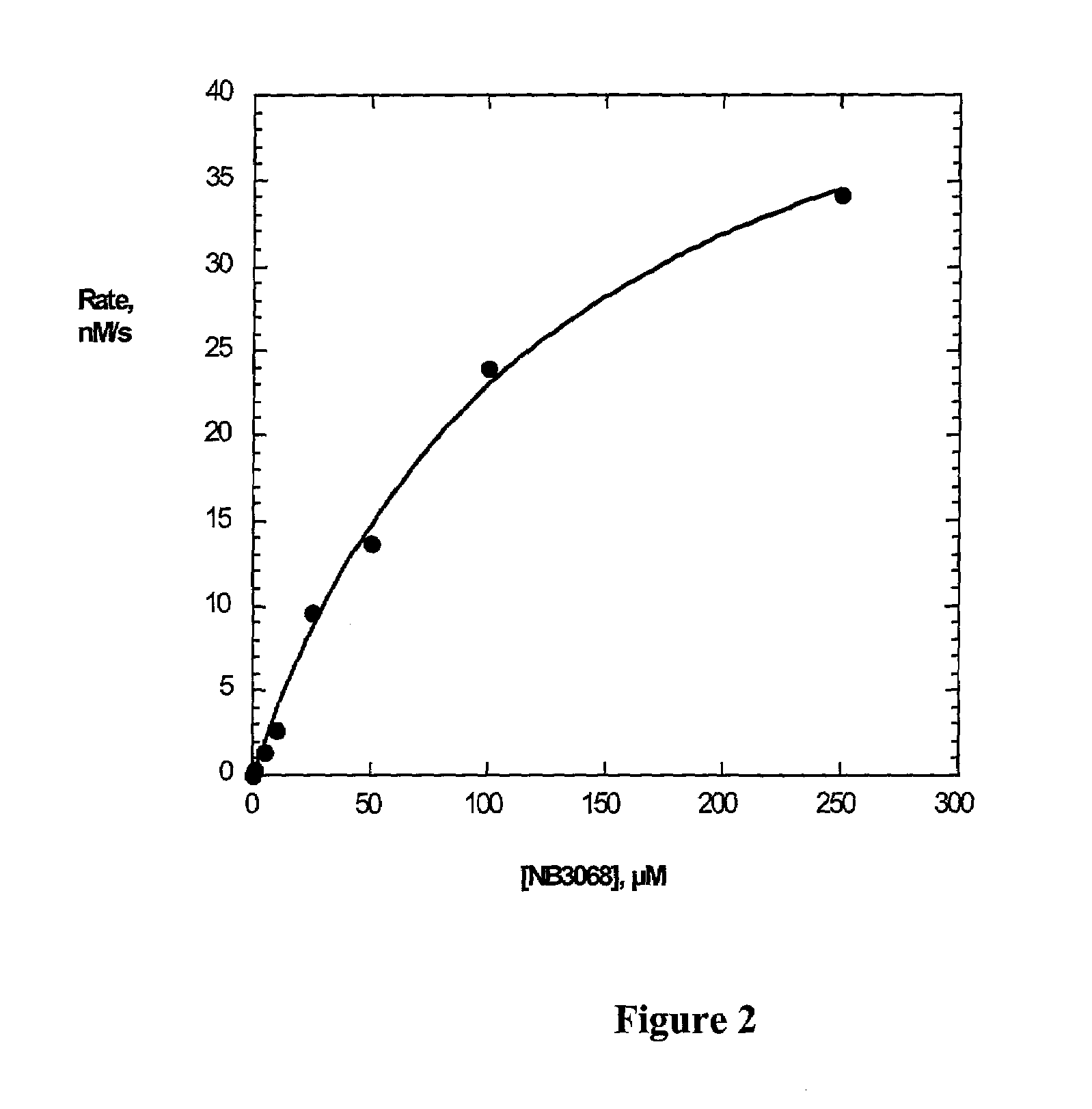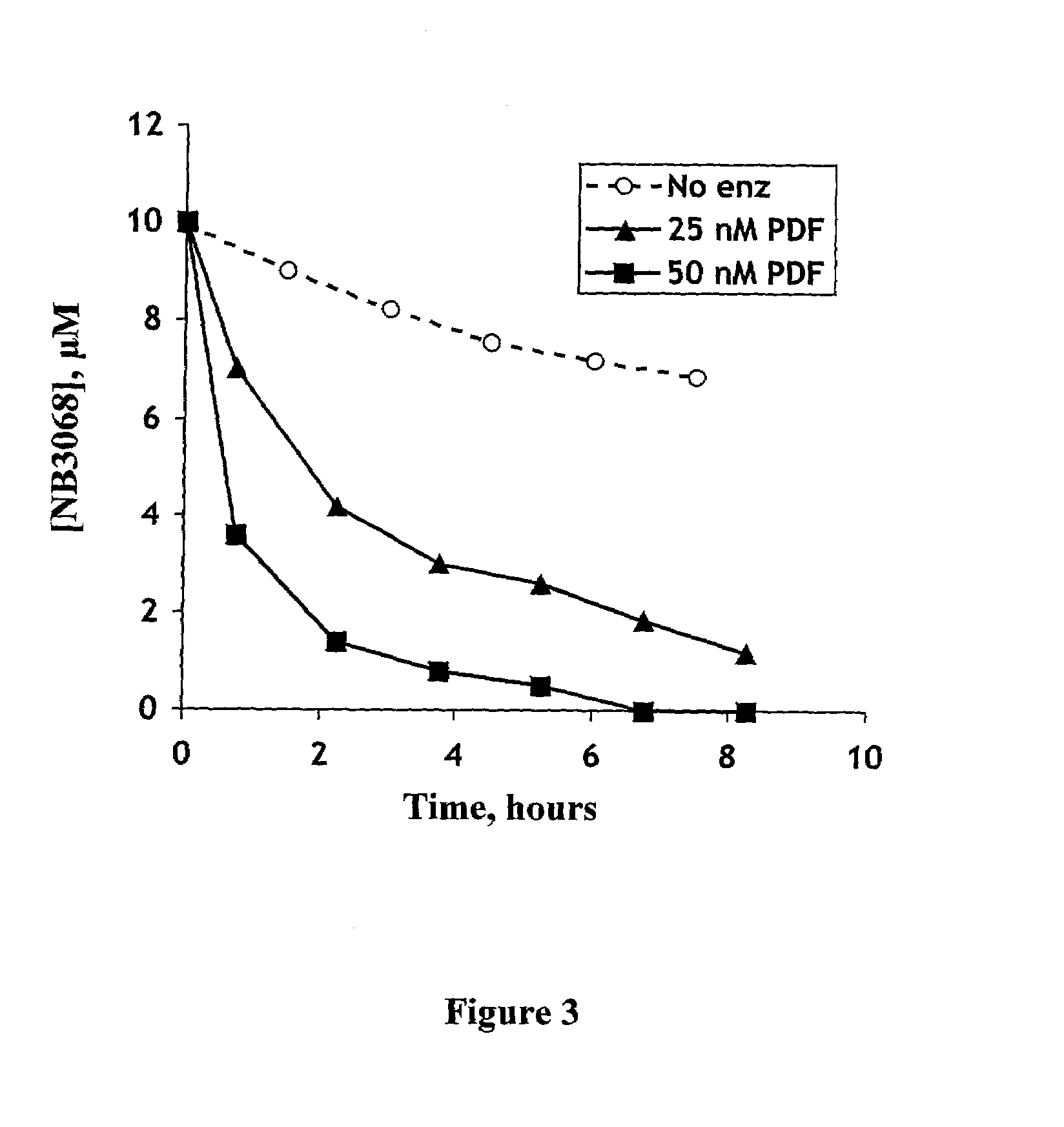Peptide deformylase activated prodrugs
a technology of activated prodrugs and deformylase, which is applied in the direction of peptides, chemical treatment enzyme inactivation, drug compositions, etc., can solve the problems of toxicity to non-diseased or non-infected tissue, and achieve the effect of alleviating the symptoms of infection and inhibiting growth
- Summary
- Abstract
- Description
- Claims
- Application Information
AI Technical Summary
Benefits of technology
Problems solved by technology
Method used
Image
Examples
example 1
Synthetic Scheme
[0173]The following examples of the synthesis of the claimed compounds are meant to be illustrative of the synthesis of the invention and not limit the synthesis of the invention. The synthetic methods, as for example seen below, used to synthesize the compounds are well known to those skilled in the art of organic and medicinal chemistry. Substitutions, modifications or additional steps used in the synthesis of the compounds of the present invention well known to those skilled in the art of organic and medicinal chemistry are anticipated. See, e.g., J. March, ADVANCED ORGANIC CHEMISTRY: REACTIONS, MECHANISMS AND STRUCTURE, 4th edition (John Wiley & Sons, NY (1992)).
[0174]
[0175]In the above synthetic scheme and the following examples, the following acronyms and definitions apply: N-tert-butoxycarbonyl (BOC); benzotriazol-1-yloxytris(dimethylamino)phosphonium hexafluorophosphate (BOP); -triethylamine (TEA); tetrahydrofuran (THF); room temperature (RT); trifluoroacetic...
example 2
[0215]The NCCLS (National Committee for Clinical Laboratory Standards), method to determine MIC's of antimicrobial compounds is modified for high-throughput screening. All stocks of tested compounds are prepared in either water or in DMSO depending on solubility. At the highest concentration, DMSO content should not exceed 0.5%. Briefly, twenty 2-fold serial dilutions of test compounds from the highest concentration are made in a 384-well microtiter plate. Each well is inoculated with testing bacteria in broth to a final concentration of approximately 1–1.5×106 cells / ml. Bacterial growth is determined by the increase of optical density at 600 nm using a microplate reader (Tecan SpectraFluor Plus). The MIC is defined as the lowest concentration at which bacterial growth (equivalent to visible growth) was inhibited after 16 to 18 hours of incubation at the appropriate temperature required for the bacteria growth. Results for NB2046 are shown in Table 3 and Table ...
example 3
[0222]In a seperate experiment, cell-free reaction of PDF ECTA compounds has been studied using PDF purified from PDF-overexpressing E. coli following a procedure described in Ragusa S., et al. (2000) and Wei, et al. (2000b). NB3068 conversion was used as an example of a PDF ECTA reaction catalyzed by purified PDF. It was carried out in 50 mM HEPES buffer, pH 7.5 at room temperature. NB3068 concentrations were in the range of 2–250 μM, and the concentration of the enzyme in the reaction mixture was 25 nM. The conversion was monitored by direct injection of the reaction mixture onto an HPLC column (Adsorbosphere HS, C18, 5 μm, 4.6 mm×150 mm, Alltech). Both the decrease of NB3068 concentration and the increase of ciprofloxacin concentration were monitored, and initial rates of the reactions were calculated. Kinetic parameters of the reaction were determined fitting the data to the Michaelis-Menten equation. The dependence of the rate of the reaction on the substrate concentration is g...
PUM
| Property | Measurement | Unit |
|---|---|---|
| Fraction | aaaaa | aaaaa |
| Fraction | aaaaa | aaaaa |
| Fraction | aaaaa | aaaaa |
Abstract
Description
Claims
Application Information
 Login to View More
Login to View More - R&D
- Intellectual Property
- Life Sciences
- Materials
- Tech Scout
- Unparalleled Data Quality
- Higher Quality Content
- 60% Fewer Hallucinations
Browse by: Latest US Patents, China's latest patents, Technical Efficacy Thesaurus, Application Domain, Technology Topic, Popular Technical Reports.
© 2025 PatSnap. All rights reserved.Legal|Privacy policy|Modern Slavery Act Transparency Statement|Sitemap|About US| Contact US: help@patsnap.com



